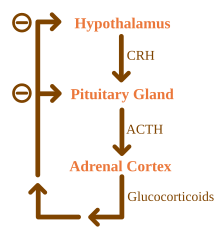Negative feedback

Negative feedback is the use of information about a difference between the actual value and the ideal value of a system parameter to reduce the magnitude of that difference.[1] If a system has overall a high degree of negative feedback, then the system will tend to be stable. By contrast, positive feedback is the use of information about a difference between the actual value and the ideal value of a system parameter to increase the magnitude of that difference.
Overview
In many physical and biological systems, qualitatively different influences can oppose each other. For example, in biochemistry, one set of chemicals drives the system in a given direction, whereas another set of chemicals drives it in an opposing direction. If one, or both of these opposing influences are non-linear, equilibrium point(s) result.
In biology, this process (generally biochemical) is often referred to as homeostasis; whereas in mechanics, the more common term is equilibrium.
In engineering, mathematics and the physical and biological sciences, common terms for the points around which the system gravitates include: attractors, stable states, eigenstates/eigenfunctions, equilibrium points, and setpoints.
Negative refers to the sign of the multiplier in mathematical models for feedback. In delta notation, output is added to or mixed into the input. In multivariate systems, vectors help to illustrate how several influences can both partially complement and partially oppose each other.
In contrast, positive feedback is feedback in which the system responds so as to increase the magnitude of any particular perturbation, resulting in amplification of the original signal instead of stabilization. Any system where there is a net positive feedback will result in a runaway situation. Both positive and negative feedback require a feedback loop to operate.
Negative feedback is used to describe the act of reversing any discrepancy between desired and actual output.
Use
Mechanical engineering

Negative feedback was first implemented in the 16th Century with the invention of the centrifugal governor. Its operation is most easily seen in its use by James Watt to control the speed of his steam engine. Two heavy balls on an upright frame rotate at the same speed as the engine. As their speed increases they swing up and outwards due to the centrifugal force. This causes them to lift a mechanism which closes the steam inlet valve and the engine slows. When the speed of the engine falls too far, the balls will fall by gravity and open the steam valve.
Control systems

Examples of the use of negative feedback to control its system are: thermostat control, phase-locked loop, hormonal regulation (see diagram above), and temperature regulation in animals.
A simple and practical example is a thermostat. When the temperature in a heated room reaches a certain upper limit the room heating is switched off so that the temperature begins to fall. When the temperature drops to a lower limit, the heating is switched on again. Provided the limits are close to each other, a steady room temperature is maintained. Similar control mechanisms are used in cooling systems, such as an air conditioner, a refrigerator, or a freezer.
Biology and chemistry

Some biological systems exhibit negative feedback such as the baroreflex in blood pressure regulation and erythropoiesis. Many biological process (e.g., in the human anatomy) use negative feedback. Examples of this are numerous, from the regulating of body temperature, to the regulating of blood glucose levels. The disruption of feedback loops can lead to undesirable results: in the case of blood glucose levels, if negative feedback fails, the glucose levels in the blood may begin to rise dramatically, thus resulting in diabetes.
For hormone secretion regulated by the negative feedback loop: when gland X releases hormone X, this stimulates target cells to release hormone Y. When there is an excess of hormone Y, gland X "senses" this and inhibits its release of hormone X.
Economics
In economics, automatic stabilisers are government programs which work as negative feedback to dampen fluctuations in real GDP.
Electronic amplifiers
The negative feedback amplifier was invented by Harold Stephen Black at Bell Laboratories in 1927, and patented by him in 1934. Fundamentally, all electronic devices (e.g. vacuum tubes, bipolar transistors, MOS transistors) exhibit some nonlinear behavior. Negative feedback corrects this by trading unused gain for higher linearity (lower distortion). An amplifier with too large an open-loop gain, possibly in a specific frequency range, will additionally produce too large a feedback signal in that same range. This feedback signal, when subtracted from the original input, will act to reduce the original input, also by "too large" an amount. This "too small" input will be amplified again by the "too large" open-loop gain, creating a signal that is "just right". The net result is a flattening of the amplifier's gain over all frequencies (desensitising). Though much more accurate, amplifiers with negative feedback can become unstable if not designed correctly, causing them to oscillate. Harry Nyquist of Bell Laboratories managed to work out a theory about how to make this behaviour stable.
Negative feedback is used in this way in many types of amplification systems to stabilize and improve their operating characteristics (see e.g., operational amplifiers).
See also
References
- ^ Arkalgud Ramaprasad, On The Definition of Feedback, Behavioral Science, Volume 28, Issue 1. 1983. Accessed on 16-03-2012.
- ^ Raven, PH; Johnson, GB. Biology, Fifth Edition, Boston: Hill Companies, Inc. 1999. page 1058.

